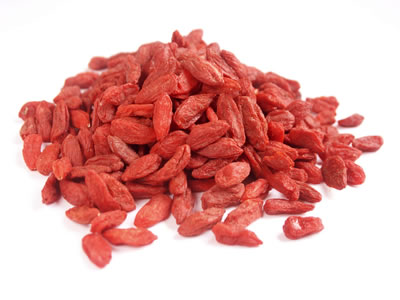Goji berries have become popular in the West since the early 21st century. Goji berries have been termed a superfruit, the “most nutritionally dense food on Earth.” Recent years, there is an increasing demand of goji berries in health food and supplement markets in the world.
Goji Berries (Go ji, Gou Qi, Wolfberry) are fruits of a woody perennial plant in the Solanaceae family. Goji Berries are orange-red fruits, smaller than grapes. Dried goji berries have a similar shape as raisins with a slightly sweet taste.
Benefits of goji berries
Dried goji berries have been used as a food and herbal tonic in China for thousands of years. Traditionally, goji berries are used as a food and medicine. Dried berries are added to tonic soups combined with ginseng, huang qi, and chicken. It is also used to make a herbal tea combined with chrysanthemum. People also use goji berries to make juice or wine, or cook with rice congee. The young leaves can be eaten as a leaf vegetable.
In traditional Chinese medicine (TCM), goji is a tonic that nourishes liver and helps treat liver-blood deficiency. Goji berries are often combined in the formulas for improving eye vision, sexual functions and promoting longevity.
Modern studies have shown that goji berries may have potential anti-aging, anticancer and immunomodulatory activities against vision-related diseases, such as age-related macular degeneration and glaucoma, cardiovascular and inflammatory diseases, and chronic liver diseases. Researchers have found that goji berries contain rich antioxidants, particularly carotenoids such as beta-carotene and zeaxanthin. The health benefits of goji berries include:
– Nourish liver blood
– Help eyesight
– Anti-aging and promote longevity
– Improve sex drive and fertility
– Boost immune function
– Improve circulation
How to make goji berry and chrysanthemum tea
Goji chrysanthemum tea is a folk remedy well known in China for cleansing liver and improving eye sight. Chrysanthemums are the genus in the family Asteraceae, native to Asia. Chrysanthemum is a cooling herb. It has liver-cleansing and eyesight-improving properties. Goji has liver-nournishing and eye-vision-improving properties. The tea has effects to help strengthen the eye vision by nourishing liver blood, and reducing liver heat. It also helps fight against aging, and lower blood pressure and stress. Here is how to make the tea:
– Dried goji berries 10g
– Dried chrysanthemum 3g
– Rock sugar (or white sugar, or honey, optional) 1 teaspoon
– Boiling water 1 cup
– Steep for 15 minutes
– Drink the tea and eat the berries
How to make goji berry tincture
Goji berries can be used to make a herbal tincture. Goji berry tincture is used as a liver and anti-aging tonic. Here is how to make it:
– Dried goji berries 50g
– Grain alcohol 35%-85% 500ml
– Soak the berries in the alcohol for 4 weeks
– Drink 20ml, once a day
Please note, goji berries have mild tonifying properties, you should not expect to see the significant improvement of your eye sight or liver functions after consuming the berries a few days. It takes time. Its blood-nourishing effect is moderate, compared to Dang Gui (Dong Quai). Goji berries have anti-aging properties and can improve sexual dysfunction in seniors, but the effect is also mild to moderate, compared to antler velvet. For long term use of goji berries, you should consult your doctor.
References
- Wolfberry: Nature’s Bounty of Nutrition and Health, Gross, P.M./Zhang, R./Zhang, X. 2006, BookSurge Publishing. ISBN 978-1-4196-2048-5
- The content of zeaxanthin in Gou Qi Zi, a potential health benefit to improve visual acuity, Lam K-W, But P, 1999, Food Chem. 67 (2): 173–6.



